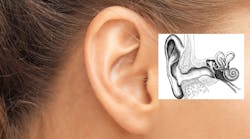Researchers Discover the Secret to How We Can Pick Out a Voice in a Crowd
More than 30 million Americans suffer from hearing loss, and about 6 million of them wear hearing aids. Although those devices amplify the intensity of sounds coming into the ear, they are often useless in noisy environments such as restaurants and parties when you need to pick out the voice of just one person from background noise.
To do that, the ear needs to distinguish sounds with subtle differences. Although humans can do that quite well, doctors and audiologists have never known how the ear (or brain) accomplishes this task. Recent findings from MIT researchers could explain the phenomenon and lead to better hearing aids.
It has been known for more than 50 years that sound waves entering the ear travel along the spiral-shaped, fluid-filled cochlea in the inner ear. Hair cells lining the ribbon-like basilar membrane in the cochlea translate those sound waves into electrical impulses that are sent to the brain. As sound waves travel along the basilar membrane, they “break” at different points, much as ocean waves break on the beach. The break location helps the ear sort sounds of different frequencies.
It wasn’t until 2007 that scientists discovered the tectorial membrane that also lines part of the cochlea and what it does. The membrane is made of a gel-like material not found elsewhere in the body, and the entire membrane could fit inside a one-inch segment of human hair. The viscosity of this membrane, its firmness (or lack thereof), depends on the size and distribution of tiny pores along the membrane, just a few tens of nanometers wide.
This optical microscope image depicts wave motion in a cross-section of the tectorial membrane, part of the inner ear. This membrane is a microscale gel, smaller in width than a single human hair, and it plays a key role in stimulating sensory receptors of the inner ear. Waves traveling on this membrane control our ability to separate sounds of varying pitch and intensity. (Courtesy: MIT’s Micromechanics Group)
This, in turn, provides mechanical filtering that helps to sort out specific sounds. It carries sound waves inside the cochlea moving from side to side. Up-and-down waves travel along the basilar membrane. Together, the two membranes activate enough hair cells so that individual sounds are detected, but not so many that sounds can’t be distinguished from each other.
Much of a person’s ability to differentiate among sounds is based on frequency, so until now researchers had assumed the better a person can resolve frequency, the better they can hear. But this assumption turns out not always to be true. In fact, MIT researchers discovered that tectorial membranes with a certain genetic defect are actually highly sensitive to variations in frequency; the result is worse hearing, not better.
The MIT team eventually found a fundamental tradeoff between how well you can resolve different frequencies and how long it takes to do it. That makes finer frequency discrimination too slow to be useful in real-world sound selectivity.
Previous work by the MIT team showed that the tectorial membrane plays a fundamental role in sound discrimination by carrying waves that stimulate a particular kind of sensory receptor. This process is essential in deciphering competing sounds, but it takes place too quickly for neural processes to keep pace. Nature, over the course of evolution, appears to have produced an effective electromechanical method of keeping up with the speed of these sound waves.
The researchers identified two genetic variants that cause nanopores in the tectorial membrane to be smaller or larger than normal. They found that the pore size affects the membrane’s viscosity and its sensitivity to different frequencies. For example, the team was able to determine that the typical pore size observed in mice, about 40 nanometers across, is the best size for combining frequency discrimination with overall sensitivity. Pores that are larger or smaller impair hearing.
This changes the way biologists think about this structure. Fluid viscosity and pores are essential to the ear’s function. Changing the sizes of tectorial membrane nanopores, via biochemical manipulation or other means, could provide new ways to alter hearing sensitivity and frequency discrimination.


